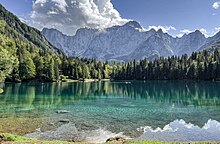Fusine in Valromana
Fusine in Valromana | ||
|---|---|---|
Dialing code 0428 | | |
| Patron saint | Saint Leonard | |
| Saint day | 6 November | |
Fusine in Valromana (
Name
The locality takes its name from the Slovene (Fužine) and Friulian (Fusinis) term for the historic ironworks site. The Italian name is a slight modification from the Friulan, with "in Valromana" added, referring to an adjacent valley—which, however, is located a fair way off. The alternate Slovene denotation Bela Peč, like the German name Weißenfels, lit. 'white rock', refers to a historic castle erected by the Counts of Celje, owners of the area between 1418 and 1456, in the early 15th century.
Geography

The hamlet is located in the western
The mountains and lakes in the vicinity of Fusine in Valromana are popular destinations for mountaineers and trekkers. The upper and lower lakes "Laghi di Fusine" fed by artesian springs on the north face of the 2,677 m (8,783 ft) high Mangart peak attract many tourists.
The area immediately surrounding both lakes is protected by the 45-hectare scenic natural park Parco naturale dei Laghi di Fusine. Meadows and pasture land above the lake belong to the Fusine in Valromana pasture cooperative. This area includes the entire valley with about 180 hectares of alpine land and 200 hectares of forest.

History

A first
In 1404, the reigning Ortenburg count Frederick III gave one Consuran Bartholomew the right to build a forge, which established the iron industry and promoted the settlement of German-speaking workers. Several more forges were operating within the village by 1456 when cooperation agreements were made with the Austrian House of Habsburg, which had inherited the estates from the last count of Celje, Ulrich II.
The Lordship of Weißenfels remained the northwesternmost part of the Habsburg
In 1862 the German firm Göppinger & Co. patented a method of making steel chains without welds. The manufacturing of chain and other hardware items in Fusine in Valromana led the industrial company to become a "global player". A successful Italian foundry founded by Guido Segre after the First World War grew to have 300 employees by 1925. In 1976 the company reached a peak of 600 employees, and in 1995, the company employed about 300 people. In 1999, Pewag, Weissenfels, and KWB (Kettenwerk Brückl), three competing firms, combined under one roof, creating the company Pewag Weißenfels International GmbH.
References
Further reading
- Das Kanaltal und seine Geschichte, Karl Migglautsch und Ingomar Pust, Herausgeber: Kanaltaler Kulturverein, Klagenfurt 1995, ISBN 3-901088-04-0
- Il parco di fusine. Un parco naturale nelle alpi giulie Regione Friuli-Venezia Giulia. Azienda delle foreste, direzione regionale delle foreste. Udine, 1971
- Die letzten Täler. Wandern und Einkehren in Friaul. G. Pilgram, W. Berger, W. Koroschitz, A. Pilgram-Ribitsch, Drava Verlag, Klagenfurt/Celovec 2008, ISBN 978-3-85435-532-8
- Duckec, Jochen (9 October 2008). "Miniera di Raibl (Raibl Mine)". Show Caves of the World. Retrieved 25 July 2009.
